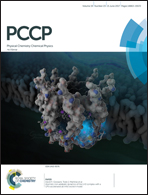Competitive C–C and C–H bond scission in the ethanol oxidation reaction on Cu(100) and the effect of an alkaline environment
Abstract
Direct ethanol fuel cell technology is impeded by inefficient, yet expensive anode catalysts. As such, research on effective and cheap anode catalysts towards complete ethanol oxidation reaction (EOR) is greatly needed. Herein, we report the investigations of the competitive C–C and C–H bond scissions in the EOR involving CH3CO, CH2CO, and CHCO species on Cu(100) using density functional theory and transition state theory calculations. The easiest C–C bond cleavage was found in CH2CO while the most difficult C–H bond cleavage was also found in CH2CO, both with an activation energy of 1.02 eV. The feasible C–C bond scission may take place in CH2CO with a rate constant ratio of the C–C to the C–H bond scission at 100 °C of 0.32. Furthermore, in an alkaline environment, the C–H bond scission activation barrier is considerably lowered but the C–C bond cleavage activation barrier is slightly increased for both CH3CO and CH2CO species. The reaction of CH3CO species on Cu(100) under alkaline conditions produces mainly acetic acid with a barrier of 0.49 eV and a rate constant of 4.93 × 105 s−1 at 100 °C.



 Please wait while we load your content...
Please wait while we load your content...